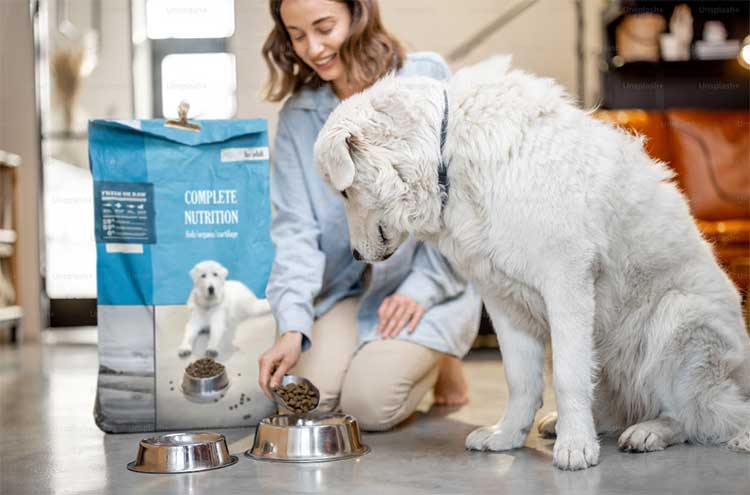If you’ve ever stood in the pet food aisle, feeling a bit lost while reading the ingredients list on a bag of kibble, you’re not alone. Pet food labels can be confusing, with terms that might sound healthy but could be masking ingredients you’d rather avoid. In this post, we’ll explore what common terms like “meal,” “by-products,” and others really mean, what implications they have on your pet’s health, and why opting for natural options is often the best choice for your furry friends.
What Does “Meal” Really Mean?
When you see “chicken meal” or “beef meal” listed as an ingredient, you might assume it’s just concentrated chicken or beef. However, the term “meal” refers to a product that’s been rendered, meaning it’s cooked down to remove moisture and fat, leaving a powdery substance that’s used in pet food. The good news is that “meal” can be a concentrated source of protein, but the quality depends heavily on the source.
The concern arises when the meal is labeled vaguely, such as “meat meal” or “animal meal.” These terms can include a mix of different animals, including those that were diseased or expired before processing. According to a study published in the Journal of Animal Science, the quality of protein in pet food can vary significantly depending on the source, impacting the digestibility and nutritional value for your pet.
Research says that high-quality meals like “chicken meal” can provide excellent protein sources, but it’s crucial to avoid generic terms like “meat meal” that don’t specify the animal. The latter can contain lower-quality proteins that may contribute to digestive issues or even long-term health problems in pets.
The Truth About By-Products
The term “by-products” often sparks concern among pet owners, and for good reason. By-products are essentially the leftovers from food production that aren’t typically consumed by humans. This can include internal organs, bones, and other parts of the animal. While some by-products, like liver or heart, are rich in nutrients, others might not be as desirable.
For instance, “chicken by-products” can legally include beaks, feet, and feathers, which offer little nutritional value. A study from the Veterinary Medicine and Science Journal highlights that by-products vary greatly in quality, and the ambiguity of the term can make it hard for pet owners to know what they’re really feeding their pets.
Research says that feeding pets a diet high in low-quality by-products can lead to nutrient deficiencies, which might not be apparent immediately but could manifest over time as health issues like poor coat condition, lethargy, or even chronic diseases.
The Role of Fillers
 Fillers are ingredients added to pet food to bulk up the product, often at the expense of nutritional quality. Common fillers include corn, wheat, and soy. While these ingredients aren’t inherently harmful, they can be problematic for some pets, particularly those with allergies or sensitivities. Additionally, fillers tend to be high in carbohydrates, which can contribute to obesity, especially in less active pets.
Fillers are ingredients added to pet food to bulk up the product, often at the expense of nutritional quality. Common fillers include corn, wheat, and soy. While these ingredients aren’t inherently harmful, they can be problematic for some pets, particularly those with allergies or sensitivities. Additionally, fillers tend to be high in carbohydrates, which can contribute to obesity, especially in less active pets.
A study in the Journal of Nutrition found that high levels of carbohydrates in pet diets, particularly those derived from fillers, can lead to weight gain and associated health problems like diabetes in pets. Research says that pets, particularly cats, thrive on diets higher in protein and lower in carbs, aligning more closely with their natural dietary needs as carnivores.
Artificial Preservatives and Additives
Many commercial pet foods contain artificial preservatives like BHA, BHT, and ethoxyquin to extend shelf life. While these chemicals are approved for use in pet foods, there’s ongoing debate about their safety. Some studies suggest that prolonged exposure to these preservatives could be linked to certain health issues, including cancer.
For instance, a study published in the Journal of Toxicology raised concerns about the long-term effects of BHA and BHT, commonly used in both human and pet foods. The study found that while these chemicals are safe in small amounts, cumulative exposure over time might increase the risk of cancer.
Research says that opting for pet foods preserved with natural alternatives, such as vitamin E (often labeled as mixed tocopherols) or vitamin C, can reduce the risk of potential adverse effects associated with artificial preservatives.
The Benefits of Choosing Natural Options
When it comes to your pet’s diet, natural ingredients can make a significant difference. Natural pet foods often contain whole proteins, like deboned chicken or beef, and avoid vague terms like “meat meal” or “animal by-products.” They also tend to use whole grains or grain alternatives, such as sweet potatoes or peas, which are less likely to trigger allergies.
A comprehensive review in the Journal of Animal Science and Biotechnology highlights that pets fed diets rich in natural ingredients typically have better overall health outcomes, including improved digestion, shinier coats, and more energy. The study emphasized the importance of a balanced diet that mimics the natural diet of wild animals, which is higher in protein and lower in unnecessary fillers and artificial additives.
Research says that by choosing natural, high-quality pet food, you’re not only supporting your pet’s immediate health but also contributing to their long-term well-being. This approach helps prevent common issues like obesity, digestive problems, and chronic diseases, leading to a healthier, happier life for your pet.
How to Decode Pet Food Labels
 Understanding pet food labels is the first step in making informed decisions about your pet’s diet. Here’s a quick guide to help you decode some of the most common terms:
Understanding pet food labels is the first step in making informed decisions about your pet’s diet. Here’s a quick guide to help you decode some of the most common terms:
- “Meal”: Look for named sources like “chicken meal” or “beef meal,” which are generally high-quality protein sources. Avoid generic terms like “meat meal” or “animal meal.”
- “By-Products”: Prefer foods that list specific organs like “chicken liver” rather than vague terms like “by-products.” Quality by-products can be nutritious, but it’s essential to know what you’re getting.
- “Fillers”: Choose foods with whole grains or grain alternatives rather than those packed with corn, wheat, or soy. Pets with allergies or sensitivities may benefit from grain-free options.
- Artificial Preservatives: Opt for foods preserved with natural alternatives like mixed tocopherols (vitamin E) or ascorbic acid (vitamin C) instead of BHA, BHT, or ethoxyquin.
- Whole Proteins: Foods that list whole proteins like “deboned chicken” or “salmon” as the first ingredient are generally of higher quality and better suited to your pet’s nutritional needs.
Making the Switch to Natural Pet Food
Transitioning your pet to a natural diet doesn’t have to be daunting. Start by gradually mixing the new food with your pet’s current food, increasing the amount of the new food over a week or two. This slow transition helps prevent digestive upset and allows your pet to adjust to the new diet.
Remember, the best diet for your pet is one that meets their specific needs. Whether you have a senior dog with joint issues, a high-energy puppy, or a cat with a sensitive stomach, there are natural food options available to support their health.
Final Thoughts
Navigating the world of pet food labels can be overwhelming, but armed with the right knowledge, you can make informed choices that support your pet’s health and longevity. By understanding what terms like “meal,” “by-products,” and “fillers” really mean, and by choosing natural options, you’re investing in your pet’s future.
Research says that a diet rich in natural ingredients, free from unnecessary fillers and artificial additives, can lead to a healthier, happier pet. So the next time you’re in the pet food aisle, take a moment to read the labels carefully—your pet will thank you for it.


